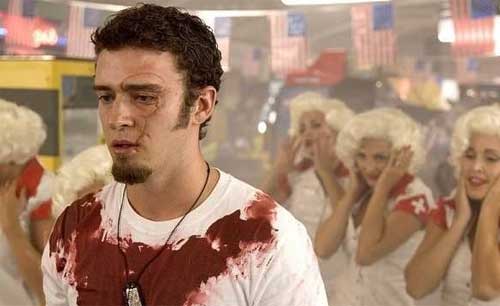Title: Celia Aka Celia: Child of Terror
Director: Ann TurnerReleased: 1988
Starring: Rebecca Smart, Nicholas Eadie, Victoria Longley, Mary-Anne Fahey, Margaret Ricketts, Alexander Hutchinson, Adrian Mitchell, Callie Gray, Martin Sharman, Clair Couttie, Alex Menglet, Amelia Frid, William Zappa, Feon Keane, Louise Le Nay
Plot: Celia (Smart) is a nine year old with
an active imagination growing up in 1950s suburban Melbourne, who constantly
escapes into a fantasy world to escape the ongoing troubles around her, while
society deals with both the fear of communism and the rabbit plague.
Review: This might be the vaguest Alt. Christmas movie
I’ve covered to date, especially when the sole link we get to Christmas is in the
opening scene which see’s Celia’s class breaking up for the holiday, while the
blackboard reads “Merry Christmas” that’s it! No Christmas trees or
celebrations, just some festive words on a blackboard. So while the link might
not be the greatest, it does however mean I get to cover this obscure
Australian film which sits amongst the likes of “Lord of the Flies” and “War of
the Buttons” with a playful dark side which at the same time left me wanting to
compare this film to arguably Peter Jackson’s best film “Heavenly Creatures”.
Its worth pointing out that this isn’t a
horror film as for some reason the distributors were seemingly keen to market
it as judging by the alternative “Child of Horror” title, no doubt the result
of them not knowing how else to sell this film, which is understandable when it
constantly seems to exist in its own unique world were Celia can switch between
blood pacts and childish feuds with her cousin Stephanie (Frid) and her committing
and covering up a violent murder with little concern for the consequences of
her actions, while the mock hanging she carries out with her friends is awhole
other thing entirely. That being said the film is frequently a fascinating and
surreal film.
The feud with Stephanie continually makes
for one of the pillars of the film here as they engage in a series of tit for
tat exhanges, with their rivally seemingly spawned out of their polar world
views as Celia fights against the rule governed world of adults, while
Stephanie is more happy to submit and more often use them to get a Celia often
via her policeman father. However this being said she too has her own bad seed
moment when she chooses to brand Celia’s rabbit seemingly out of pure spite.
For some reason these confrontations usually around the quarry where Celia and
her friends prefer to hang out for no real reason, especially when there is
nothing of any real interest there apart from an old shed and it was a setting
that I constantly thought would lead to some big moment, but sadly it’s just a
setting and nothing else.
The other main antagonist for Celia here is
her father with who she has one of the more complicated relationship with as he
constantly scoulds her for not following the rules or for her friendship with
the Tanner’s especially when he finds out that they are communists. He’s also
responsible for her losing her beloved pet rabbit “Murgatroyd” under the rules
being enforced by the authorities as part of their attempts to curb the rabbit
plague, however when given the chance to reclaim him, he’s happy for her to
believe that he has died, despite finding him a couple of minutes earlier. These
scenes of high bastardry being countered by scenes of her being taken fishing
which only makes it the more confusing how we are supposed to feel about this
relationship.
Due to Celia’s behaviour throughout the film its hard to know if this movie should be classed as a “Bad Seed” movie, especially with the events of the film being largely seen through her eyes, while her blonde hair and plats certainly bringing to mind Rhoda Penmark. At the same time a lot of her activities are carried out with her gang of sorts, making it more of a kids gone rogue movie.
This is far from the most action packed or
gory film which means that those horror fans looking for their bad seed fix
might find themselves sorely disappointed as it features neither but the interactions
between the characters and occasional set pieces really help to carry this film
which does at time feel a lot longer as a result than its surprisingly short
runtime and what stopped me from rating this film higher. That being said it
has enough interesting and occasionally shocking moments to make this one worth
hunting down, more so when it’s the kind
of film which is sadly not made enough in these times were films seem to fall
into the category of high drama or blockbuster its films like this which make
it so much fun to hunt down and experience these movies.


























